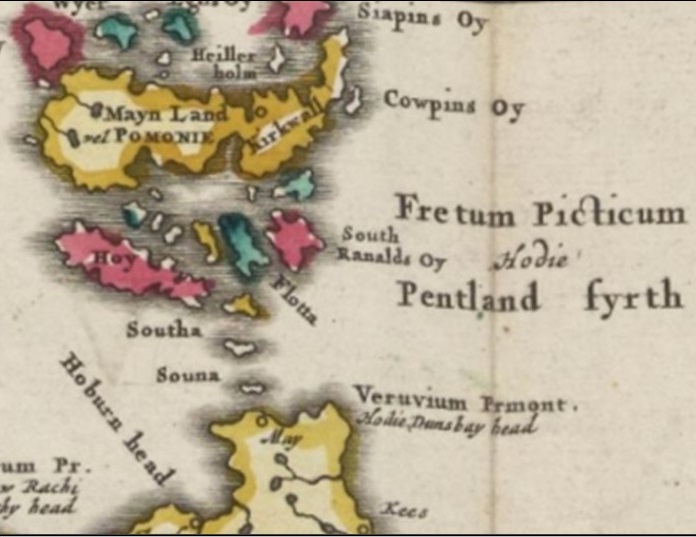
16/09/2024, by aezcr
Crossing the Sea of Orcs
The Pentland Firth is the large body of water which separates the Orkney Isles and mainland Scotland. Ferries that run to the islands cross this body of water, which is roughly 7.5 miles (12km) in length.
As such a prominent water feature, and the main crossing point to Orkney from the south, it is not surprising that the Pentland Firth is mentioned many times in Orkneyinga saga – it appears in about 20 chapters. It is mostly mentioned in descriptions of travel, or when people spot incoming ships from the Orkneys or the mainland. For example, in chapter 110, we are told that a messenger sent by Haraldr Maddaðarson is fluttr yfir Péttlandsfjǫrð (‘ferried over the Pentland Firth’).
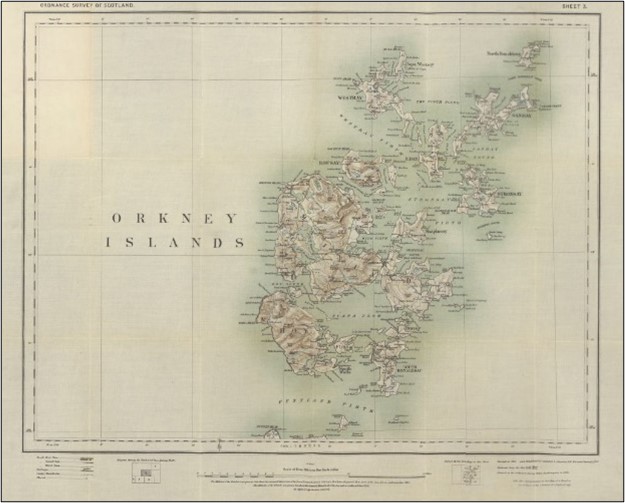
The Orkney Islands on the 1st edition OS map (1901). Reproduced with the permission of the National Library of Scotland.
The early spellings of this name which appear in the saga manuscripts suggest that the original Old Norse form was Pétlandsfjǫrðr. The final part or element of this name is the well-attested ON word fjǫrðr, referring to a firth, bay, or large body of water, especially one used for passage and travel. This word could be related to the verb ferð, which means something like ‘to travel’ or ‘to journey’.
The first part of this name, Pétlands, means ‘Pictland’. The Picts were the group who inhabited northern Scotland prior to the Norse settlement, and there may have been contact between these two groups. It makes sense that the Vikings would name the Pentland Firth after the land of the Picts, given their location in northern Scotland. The name is unrelated to the Pentland Hills near Edinburgh, which is probably instead derived from Brittonic, a Celtic language which is the ancestor of Welsh.
The early spellings of the Pentland Firth which feature in the saga are quite stable. However, a look at historical maps of the region shows that the name has undergone many changes since its early use. For example, a mid-17th century map by Robert Gordon spells it Pichtland:
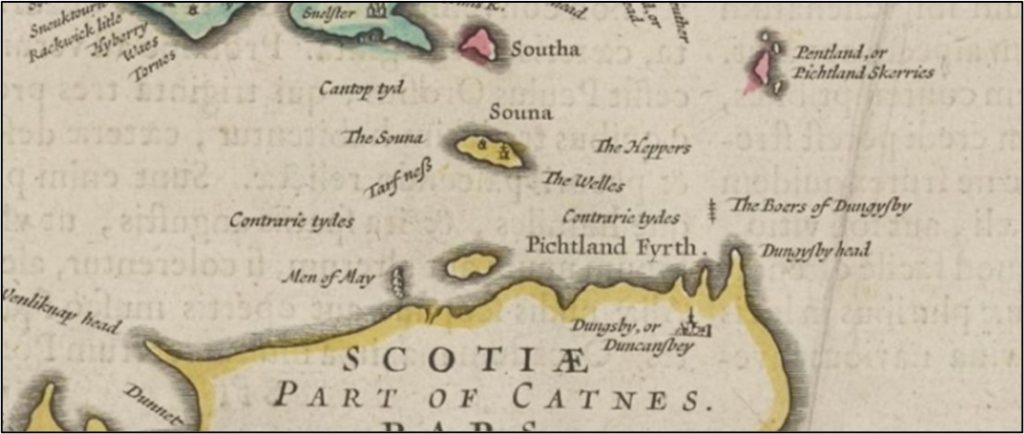
Detail from the 1654 map of Orkney by Willem Janszoon Blaeu and Joan Blaeu. Reproduced with the permission of the National Library of Scotland.
There is an interesting occurrence on a map from 1662. This map has two forms of the name: Pentland fyrth and Fretum Picticum (‘strait of the Picts’, in Latin).
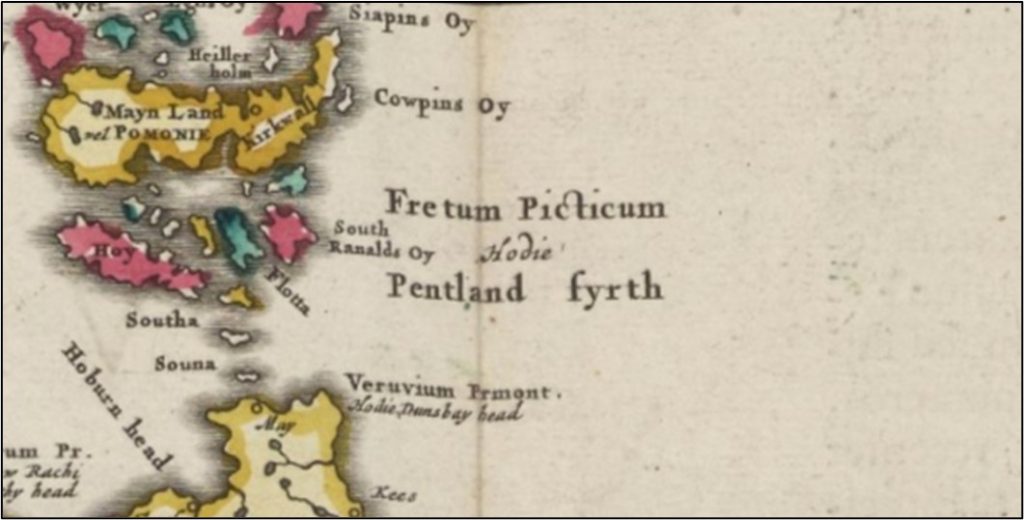
Detail from the 1662 map by Robert Gordon and Joan Blaeu. Reproduced with the permission of the National Library of Scotland.
These 17th-century spellings, Pichtland and Fretum Picticum are very interesting. They could suggest that, even though it is not necessarily explicit in the Old Norse Pétlandsfjǫrðr root, there is still an association with the Picts, and thus the names are changing to reflect this.
Then, an 18th century map by Murdoch MacKenzie has the spelling Petland Firth:
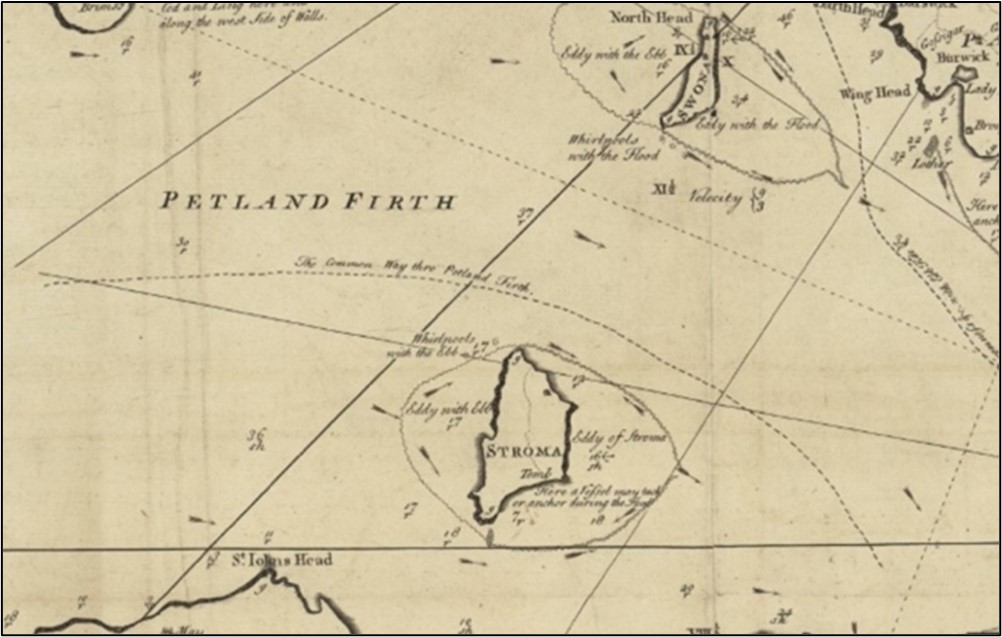
A coastal and marine map by Murdoch MacKenzie Sr, dated 1750. Reproduced with the permission of the National Library of Scotland.2
And then, by 1769, maps consistently have the modern spelling Pentland, with the –n-, such as this one:
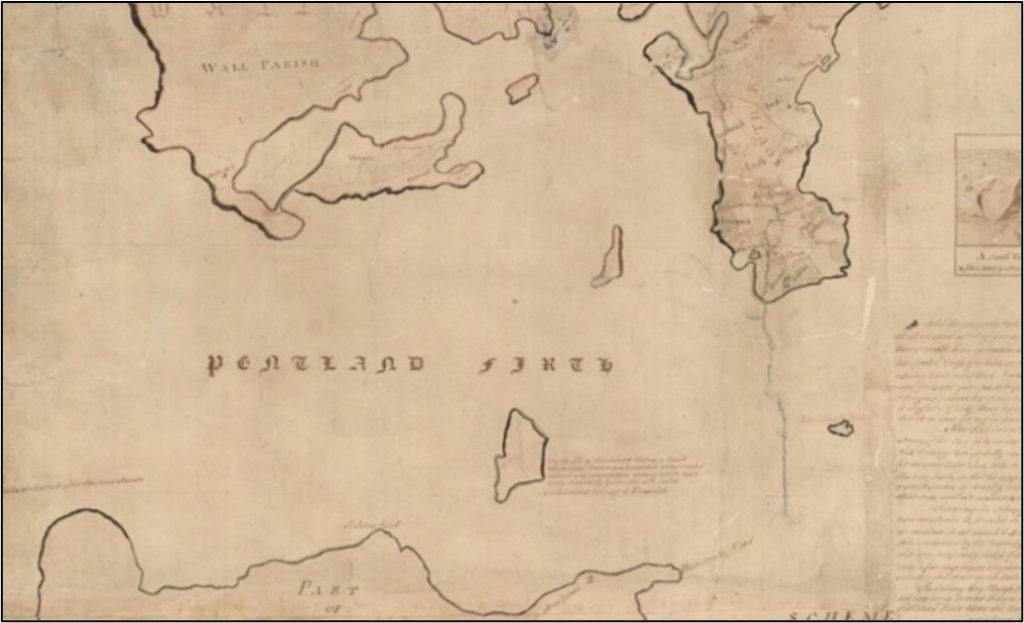
A section of a map of the Orkney Islands produced by William Aberdeen in 1769. Reproduced with the permission of the National Library of Scotland.
Interestingly, there is evidence for a pre-Norse name for this body of water. The Orkney Islands are referred to multiple times in the Historia Brittonum (‘History of the Britons’), a 9th century work attested to a Welsh monk called Nennius. In an Irish version of this text, there is reference to an area called the ‘sea of Orcs’. The Orcs were a Pictish tribe whose name is the first part of Orkney. The text reads:
Rolinsat Breatain in n-insi uile ar tus dia clannaib, o muir n-Icht co muir n-Orc.
‘The Britons originally filled the whole island with their peoples, from the English Channel to the Sea of Orcs’ (Watson 1926: 63).
This suggests that prior to the Norse name, the Pentland Firth was named from its association with the Orcs. This early name could relate to the Scottish Gaelic name for the region, which is An Caol Arcach (‘the Orcadian strait/channel’).
So, at different points of history there have been two names for this body of water: Pentland Firth, of Old Norse origin and given by Viking settlers; and an earlier ‘sea of Orcs’ name, the sense of which is similar to the modern Scottish Gaelic name.
This kind of linguistic co-existence is an interesting aspect of the Norse settlement of Orkney. The question of whether the Vikings encountered Picts, and the effect that the Pictish language had on Old Norse naming has been long debated (Rhys 2015: 183). Marwick, an authority on Orkney’s farm-names, has argued that the presence of pre-Norse words in names is not indicative of the survival of the pre-Norse, Pictish language – rather instead that they are borrowings from this language used by Norse speakers (1952: 227). However, in the case of the Pentland Firth, different names have been used throughout its history. Pentland Firth is certainly the more common name now, especially as Scottish Gaelic has endangered status and these alternative names are at risk of being lost.
Katie Hardy
Further reading
Marwick, H. (1952). Orkney Farm-Names. Kirkwall: W. R. Mackintosh.
Rhys, G. (2015). Approaching the Pictish language: historiography, early evidence and the question of Pritenic. Published PhD thesis: University of Glasgow.
Todd, J. H. (eds., trans.) (1848). Leabhar Breathnach annso sis (The Irish Version of the Historia Brittonum of Nennius). Dublin: Irish Archaeological Society.
Watson, W. J. (1926) History of the Celtic Place-Names of Scotland. Edinburgh: William Blackwood & Sons.
Previous Post
Who were the Papar of Papay?No comments yet, fill out a comment to be the first

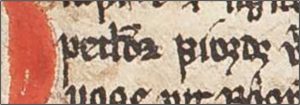
Leave a Reply